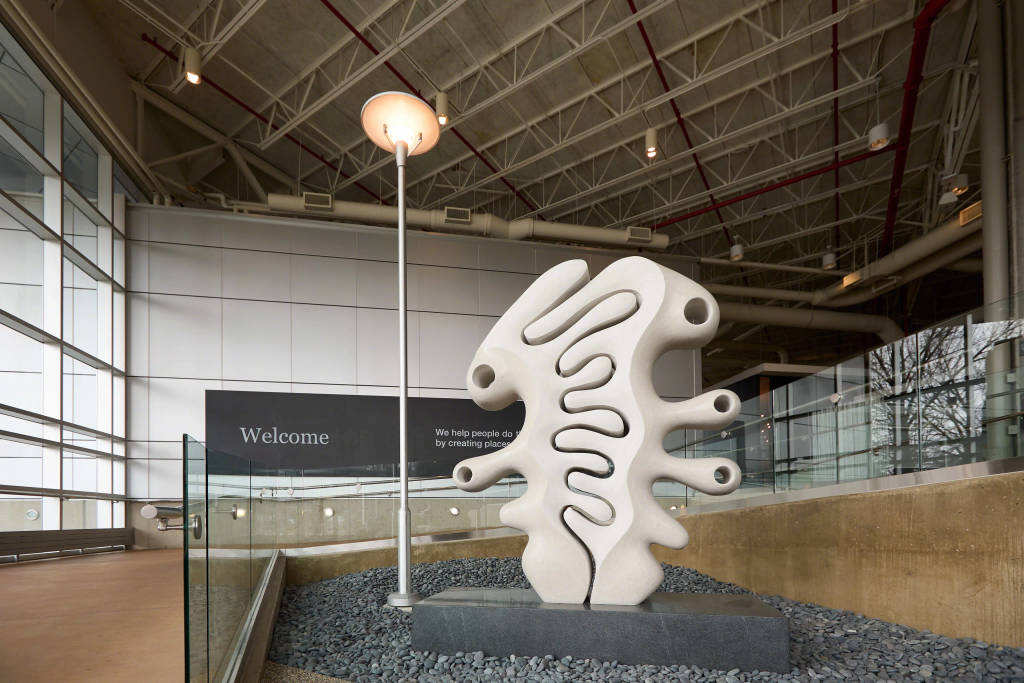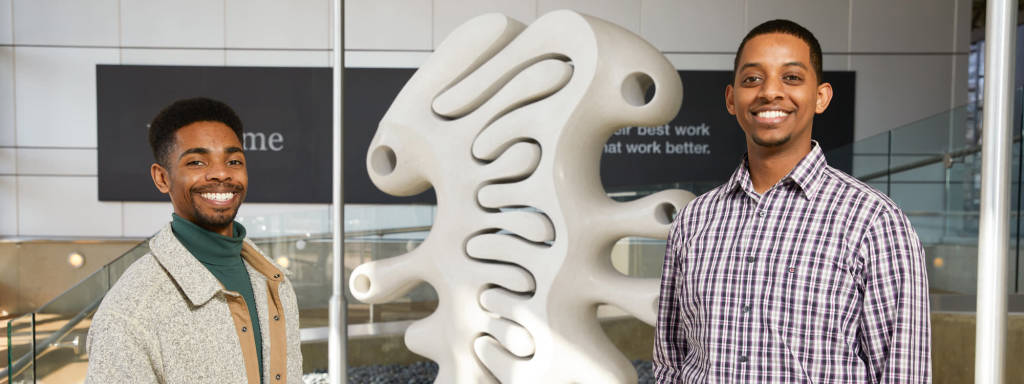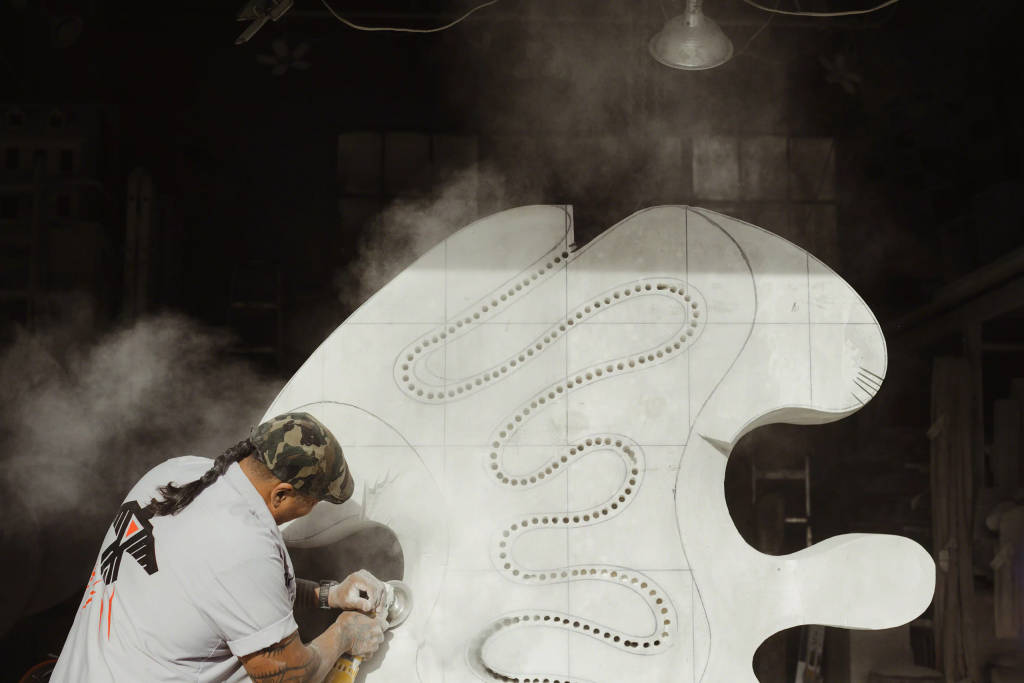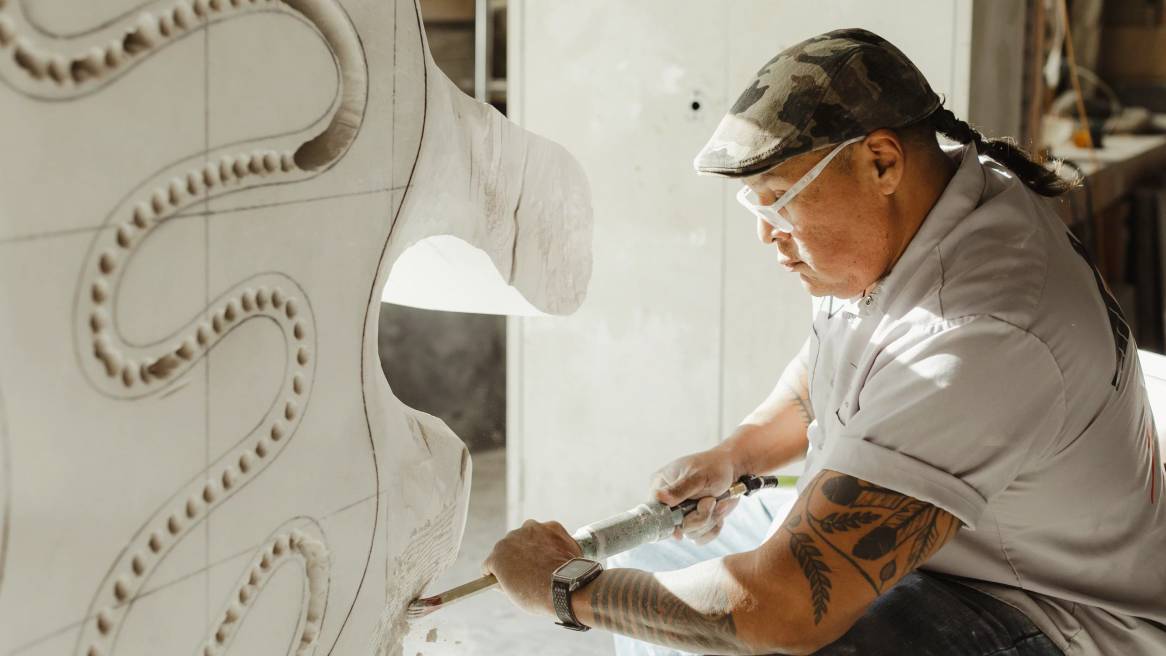Shaping Change Through Art
New sculpture represents renewed commitment to diverse environments of belonging, thanks to grassroots effort.
Steelcase acknowledges its presence on the original land of the Anishinaabe people in Western Michigan, the historic homeland of the People of the Three Fires: the Ojibwe, Odawa and Potawatomi nations and recognizes the sovereignty of the Indigenous communities here.
A shrill din screams through the Asinaabe Studios workshop, echoing off its time-worn red brick walls. As artist Jason Quigno bears his steel blade deeper into the sheer face of a limestone slab, fine powder blossoms into the blond autumn sunlight. Like the powerful winds and waters of Anishinaabe lore – Quigno gradually wears down the four-ton block, shaping it to its intended form. He’s in his element – with his element – creating a culturally significant piece with a very special purpose.
The sculpture – called Maawanji’idiwag (mah-wahn-jee-ihd-ee-wahg) – means “they come together, and meet with each other.” Quarried as one block, it was split into two pieces. Visually inspired by the headdresses of Quigno’s heritage, Maawanji’idiwag represents beauty and balance; a symbol of humanity’s interconnectedness – two separate pieces, born of a singular element – forever and irrevocably intertwined.

For many at Steelcase, Maawanji’idiwag represents a step toward positive change, promise and hope. The inspiring seven-foot sculpture now welcomes employees and visitors to the Steelcase Learning + Innovation Center in Grand Rapids, Michigan – the culmination of a grassroots, employee-driven effort to enhance inclusion and representation within the facility, and a new corporate commitment to diverse art curation.
Steelcase is on an inclusive design journey to create environments where employees, customers and guests feel valued, respected and accepted as their authentic selves. Art representative of diverse and local cultures is one way to signal an environment of belonging. For decades, Steelcase collected and displayed art to enrich its common spaces. Now, the organization is working to ensure its curation is more reflective of the diverse communities it employs and serves through a deliberate, sustained and on-going commitment to investing in emerging artists from underrepresented cultures.
“The Inclusive Art Project has been an incredible employee-driven and leader-supported effort, and we have all learned together on this journey,” says Donna Flynn, vice president of global talent. “It’s a great example of how as leaders we need to listen to all ideas and voices across the company as we seek to find new and impactful ways to nurture a culture of inclusion at Steelcase for our people.”
Empowered Employees
For Steelcase employees Reid Culberson and Fil Zerom, the sculpture – and their hard work in bringing it to fruition – is a milestone moment they believe moves the organization even closer to its goals around fostering inclusion.

The product engineers recognized when they began working at Steelcase that the spaces where they worked – unintentionally – didn’t speak to them, their culture or their lived experiences as Black men in the U.S.
“Walking into my first big corporate job, I looked around, and I couldn’t help but feel intimidated,” Culberson says. “Despite the fact that everyone was friendly and welcoming, I still felt like I didn’t belong.”
Zerom, a first generation American whose parents emigrated from Eritrea, knows well the isolation associated with feeling disconnected from the environments in which we spend the most time.
“As a child, I had to adapt to being in a different culture. I felt like I had to put on a mask. I was not the person I was when I was with my family or Eritrean friends.”
“I know how lonely it is when you feel like you can’t be yourself.”
FIL ZEROM | Steelcase engineer
Culberson and Zerom weren’t the only ones who recognized their environment didn’t represent them. They heard the same from colleagues of color, as well as interns and visitors from other states and countries. They knew they wanted to help make a change.
Around the same time, the pair was introduced to the work of Theaster Gates, a Chicago-based artist and professor who focuses on space, buildings, art, and how they intersect with people and communities. Gates’ work inspired them to start a dialogue around creating more inclusive spaces at Steelcase.
“It got us thinking – our space isn’t exclusive intentionally, but how do we impact that space to get Steelcase excited to celebrate the idea that everybody should be part of the community – that everyone should feel welcomed and valued,” Zerom says. “Theaster Gates uses art to do that. We thought – we’re a design organization, it would be cool if we could do the same thing – change through art.”
The engineers were empowered by the DEI core team to share their ideas with the organization’s leadership – which then led to the commission of Maawanji’idiwag. A team collaborated with Fil and Reid in exploring some 50 artists from underrepresented communities around the world, understanding their stories and inspiration. The group chose Quigno. There are plans for additional inclusive art commissions going forward, and Steelcase has already made investments in locally-made or indigenous art at its facilities in Munich and in Australia. Zerom and Culberson believe the new sculpture is a small step on a journey of deeper cultural inclusivity – key to attracting and retaining diverse talent and fostering greater representation throughout the organization.
“It makes me feel like my voice is being heard, and I feel more included in Steelcase as a company – as a contributor to what we’re doing here,” Culberson says. “But the job’s not done.”
“We know spaces don’t change culture – people change culture.”
REID CULBERSON | Steelcase engineer
The Art of ‘Good feeling’

With pneumatic chisel in hand, Quigno chunks shards of limestone that clink as they gather in a heap on the floor. It’s a livelihood for him, yes, but also a diligent labor of love. The Native American artist stoically embodies the values of his ancestors – his works, steeped in their influence.
“I was taught that when you make something, you infuse good feeling into it,” says Quigno from his Asinaabe Studio workshop, which translates to “stone man” in the Anishinaabe dialect.
For Quigno, a member of the Saginaw Chippewa Tribe of Michigan, Maawanji’idiwag is personal. Peering through his studio’s thin, industrial windows – vignetted by the dust of countless projects that came before – the artist is pensive. “I believe it’s part of my responsibility – because of the permanence of it – that all of my work reflects my culture,” Quigno says thoughtfully, in his low, distinctive Anishinaabe cadence. “This will be here for thousands of years.”
Maawanji’idiwag also pays homage to the teachings of ‘The Seven Grandfathers’ – humility, bravery, honesty, wisdom, truth, respect and love. Quigno believes these culturally-transcendent tenets are foundational to a strong and sustainable community.

The artist began carving rock as a teen – starting with a handheld figure he made in a stone working class. Now, shuffling through the fine powder that envelops every inch of his old industrial studio, Quigno points to the ropes and pulleys draped from the ceiling. “This work that I do – as I’ve progressed over the years – the pieces have gotten bigger and more intricate,” Quigno quips, motioning to a several-ton sculpture harnessed nearby.
His outsized works appear at the Grand Rapids Art Museum, the Gerald R. Ford International Airport in Grand Rapids, the U.S. Department of Justice in Washington, D.C., at city halls in Marquette, Michigan and Okaya, Japan – and now – at the Steelcase Learning + Innovation Center in Grand Rapids, where Maawanji’idiwag welcomes employees and visitors to the space – proudly signaling a place committed to belonging for everyone.
“What I hope people get from this piece is a sense of beauty, peace and simplicity,” Quigno says. “It’s a physical representation of how two different things can come together in harmony. You put them together in a cohesive way, it’s just beautiful. Diversity can be beautiful.”


